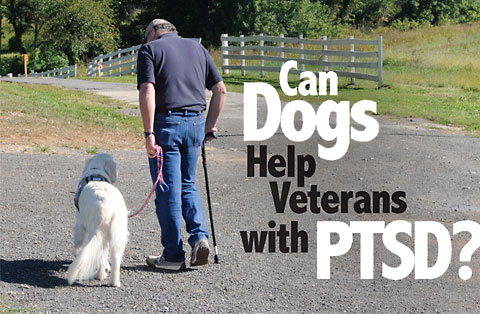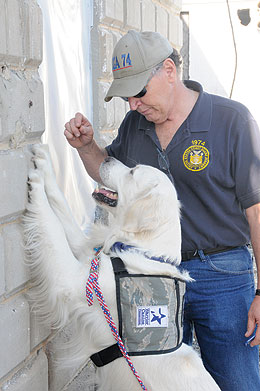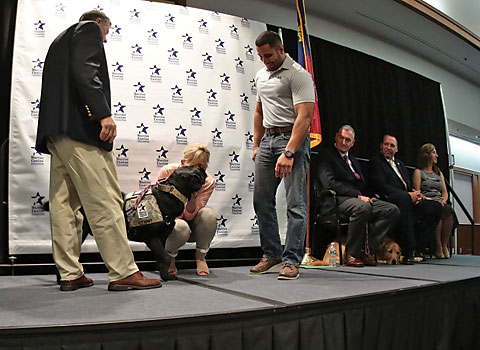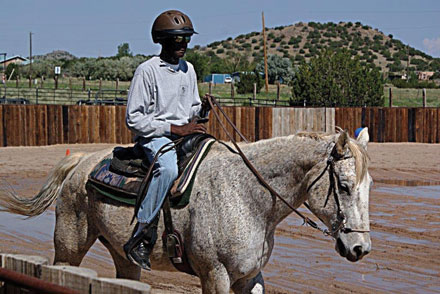 |
||||||||||||
|
November/December 2016
BY CLAUDIA GARY The auditorium buzzed with excitement, mixed with a sense of calm and well-being that seemed to emanate from the presence of the Labrador and Golden Retrievers on one side of the room. Across the aisle, several veterans waited to be officially united with their canine companions. The occasion was Warrior Canine Connection’s October 8 graduation ceremony in Rockville, Md., an annual event in which volunteer caretakers present veterans with the service dogs they have been raising and helping to train. Each graduation culminates a cycle of WCC’s combined program to help veterans with physical disabilities and those with post-traumatic stress disorder. “Used judiciously, medications can save lives,” said keynote speaker Robert Koffman. “But when was the last time you heard of someone overdosing from the sloppy kiss of a dog?” Dr. Koffman, a psychiatrist, is a retired Navy Captain who worked as a medical officer in Operation Desert Storm and during deployments in Antarctica, Iraq, and Afghanistan. He became aware of WCC’s program during studies at the National Intrepid Center for Excellence, started out as a “puppy parent,” and eventually became WCC’s Chief Medical Adviser. It’s widely agreed that dogs are good companions and can be therapeutic in certain ways without side effects. Contrary to the casual idea of an “emotional support dog,” however, assistance dogs require careful and systematic training, a process that takes more than a year. If trained service dogs are required by physically disabled veterans, the VA provides benefits such as veterinary care insurance. Several organizations train and provide service dogs for disabled veterans. WCC, an accredited member of Assistance Dogs International, has also been working for wider acceptance of dogs in PTSD therapy.
WCC’s Senior Research Adviser, Meg Daley Olmert, has studied the neuroscience of the human-animal bond for twenty years. “I immediately recognized what Rick Yount had tapped into it with this program model,” she said, “and that we could and must study it in order to establish this model as an evidence-based intervention and to ensure the program is designed to be as therapeutically effective as possible.” Olmert said the WCC program works to create “a meaningful mission to provide critically needed service dogs for wounded warriors, and to utilize the training of those dogs to assist recovery of service members and veterans suffering from combat trauma.” The WCC Mission-Based Trauma Recovery (MBTR) program, supervised by professional service-dog trainers with clinical backgrounds, has been incorporated into DoD and VA PTSD treatment programs at Walter Reed National Military Medical Center, the National Intrepid Center of Excellence, Fort Belvoir, and the Menlo Park VA Hospital. “Since MBTR’s inception,” she said, “three thousand service members and veterans report an increased sense of well-being from participation in the therapeutic training of WCC’s service dogs. WCC has also been able to place eighteen warrior-trained accredited service dogs at no cost with veterans in need of mobility, psychosocial, or family support.” In WCC’s MBTR program, the process of training each service dog involves the help of forty veterans with PTSD, yielding benefits to these veterans in addition to the one who receives the dog.
Olmert’s 2009 book, Made for Each Other: The Biology of the Human-Animal Bond, was based on fifteen years of research, including studies into the brain-chemistry changes that result from friendly interaction with dogs. These chemical reactions, in which oxytocin plays a major role, not only inspire a sense of attachment to dogs but also can reduce fear and anxiety in the dog’s handler. As Olmert explained in a 2012 TedX Talk, human bonding with dogs may have been essential to prehistoric humans’ shift from being prey animals to becoming social carnivores. A discovery of proto dog skulls 31,700 years old—from the time Neanderthals were disappearing—suggests that the ability to bond with dogs may explain how humans obtained the competitive edge. “Learning to domesticate animals—dogs and, later, horses—made us stronger and faster, and took us to places where we could never go on our own,” she said. “Oxytocin is the star of the story,” said Olmert, explaining that secretion of oxytocin decides how social you are. Maternal bonding is where this begins, since oxytocin prompts the release of a mother’s milk to her infant. But oxytocin also pervades social interaction, and is evoked, for example, by friendly interaction with dogs. In turn, oxytocin shuts off the amygdala (the brain’s fear center). “The fight-flight system is wildness,” she said. “You cannot run a hypersocial society like ours if you are in a fight-flight state. When you shut this off, you get ‘calm connect,’ modulated by oxytocin.” She also said that prehistoric humans may have bred dogs from wolves in a relatively short time, as demonstrated by an experiment that replicated this process during the 20th century using wild foxes in Siberia. Russian scientist Dmitri K. Belyaev and his colleagues selected for inherent tameness among the fox cubs in each generation. The foxes were not trained and were given minimal contact with humans. This ensured that genetics rather than experience was the major factor. After forty generations (about twenty-three years), the scientists had produced a population of domesticated foxes. Some of the descendants were still being sold as pets in 2010. Olmert explained that the MBTR model of animal-assisted therapy “provides—indeed requires—the warrior-trainers to engage in highly focused, nurturing social interactions with our dogs. This quality of social engagement with a dog most closely mimics effective parental behavior, [which] triggers a complex neurobiological system that produces a sense of calm and an urge to engage with others. This neurochemistry has also been shown to be dysregulated by traumatic brain injury and post-traumatic stress.”
Although the positive results have been clear to participants and their family members, Olmert said that explaining the WCC model and the need for research funding to military medical leaders and legislators has been “an uphill struggle.” The challenge has been to navigate between those who claimed that research wasn’t needed because dogs had obvious benefits, and those who demanded research results. A VA pilot project was undertaken in Tampa, Fla., in 2010, but it was discontinued due to biting incidents involving participants’ children. According to Olmert, such incidents may have occurred because the dogs used in those studies had been trained to be on alert and to take a protective position, at the approach of a stranger—a type of training that runs contrary to the need for dogs to “invite friendly interaction with strangers and expand the comfort zone” in order to overcome symptoms of PTSD. “If you put a dog on high alert and you are nervous and paranoid,” she said, “that’s when you’ll see a lot of dog bites occur with the approach of strangers.” Today VA research seems to be back on track, with new studies underway on the use of dogs for veterans with PTSD. Results may begin to appear in 2017 and 2018. WCC sees this as progress, although the study design is not ideal. “Although I feel that the VA study is not truly assessing the full benefits that can be gained from service dogs in reducing symptoms of PTSD,” Rick Yount said, “I am hopeful that some aspects of symptom reduction will be acknowledged through this study. We had some degree of success in having the VA include some flexibility regarding the tasks that the dogs can be trained to perform.” The idea that adopting a dog might make medications unnecessary, as well as reduce isolation and help deal with nightmares, is appealing. But WCC’s MBTR program is designed only as an adjunct therapy, not a stand-alone treatment. Even though therapy involving dogs has no side effects, it is currently subjected to far more challenging studies than “treatments as usual,” including psychiatric interventions and pharmacology. “Social isolation and sleep disruption are the disabling forces of PTSD,” Olmert said. “To address sleep disruption, dogs have been trained to wake up handlers when they are having nightmares. They also are trained to recognize alert states (such as a bouncing knee) and intervene, for example, by looking their handler in the eye.” With or without statistical evidence, it’s clear that dogs can improve life. But before running out to adopt one, remember that all dogs need owners who can provide constant care and attention. If you want to get a dog for emotional support, discuss it with your mental health care provider and those close to you.
|
||||||||||||
|
|
||||||||||||
|
||||||||||||
8719 Colesville Road, Suite 100, Silver Spring. MD 20910 | www.vva.org | contact us |
||||||||||||






















 WCC’s Executive Director, Rick Yount, pioneered the first therapeutic service dog training program at the Palo Alto, Calif., VA Hospital in 2008. His concept of involving veterans with PTSD in training mobility service dogs for fellow veterans yielded very positive results. He presented the concept at the VA National Mental Health Conference, the International Society of Traumatic Stress Studies, and elsewhere.
WCC’s Executive Director, Rick Yount, pioneered the first therapeutic service dog training program at the Palo Alto, Calif., VA Hospital in 2008. His concept of involving veterans with PTSD in training mobility service dogs for fellow veterans yielded very positive results. He presented the concept at the VA National Mental Health Conference, the International Society of Traumatic Stress Studies, and elsewhere.
